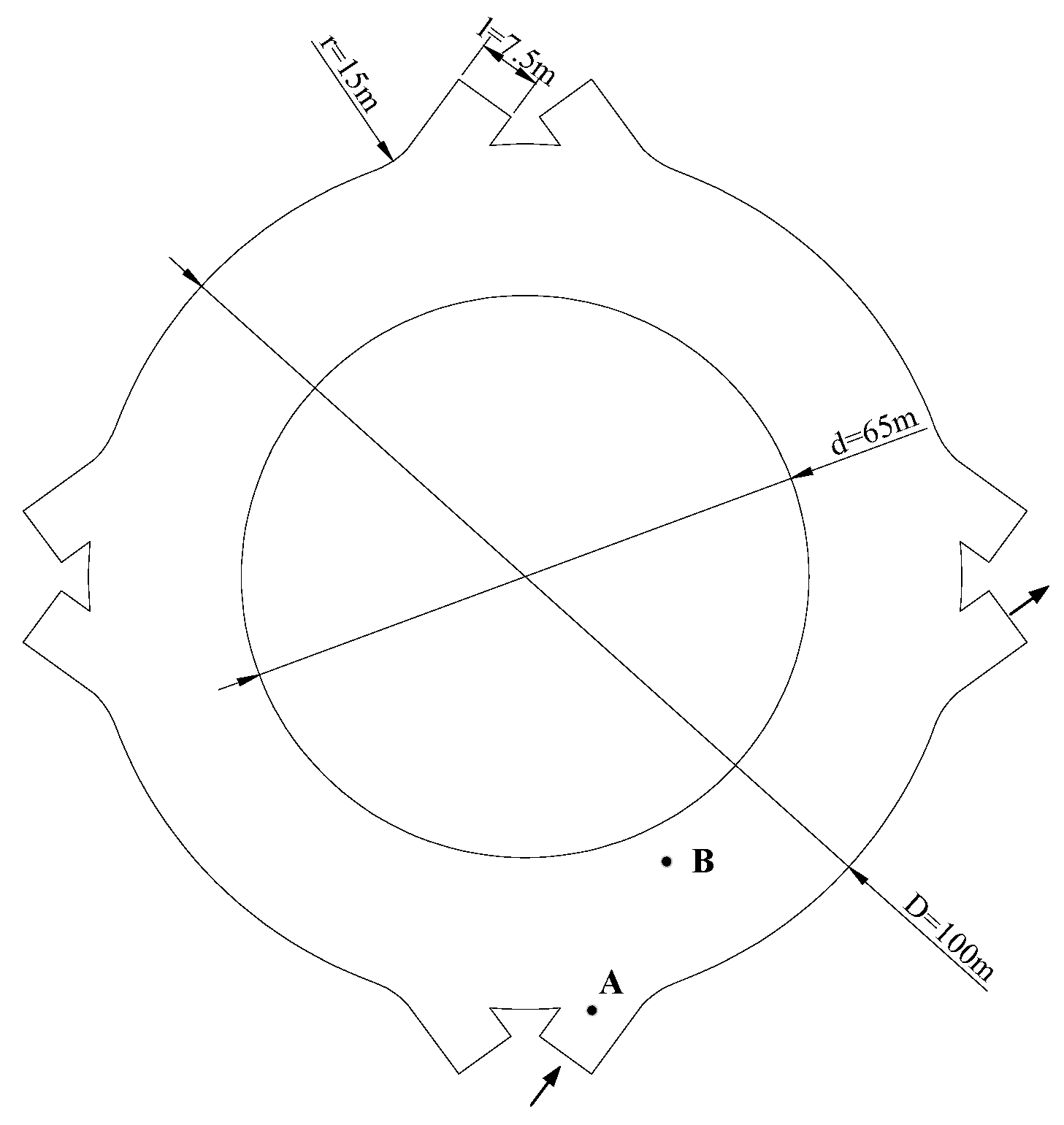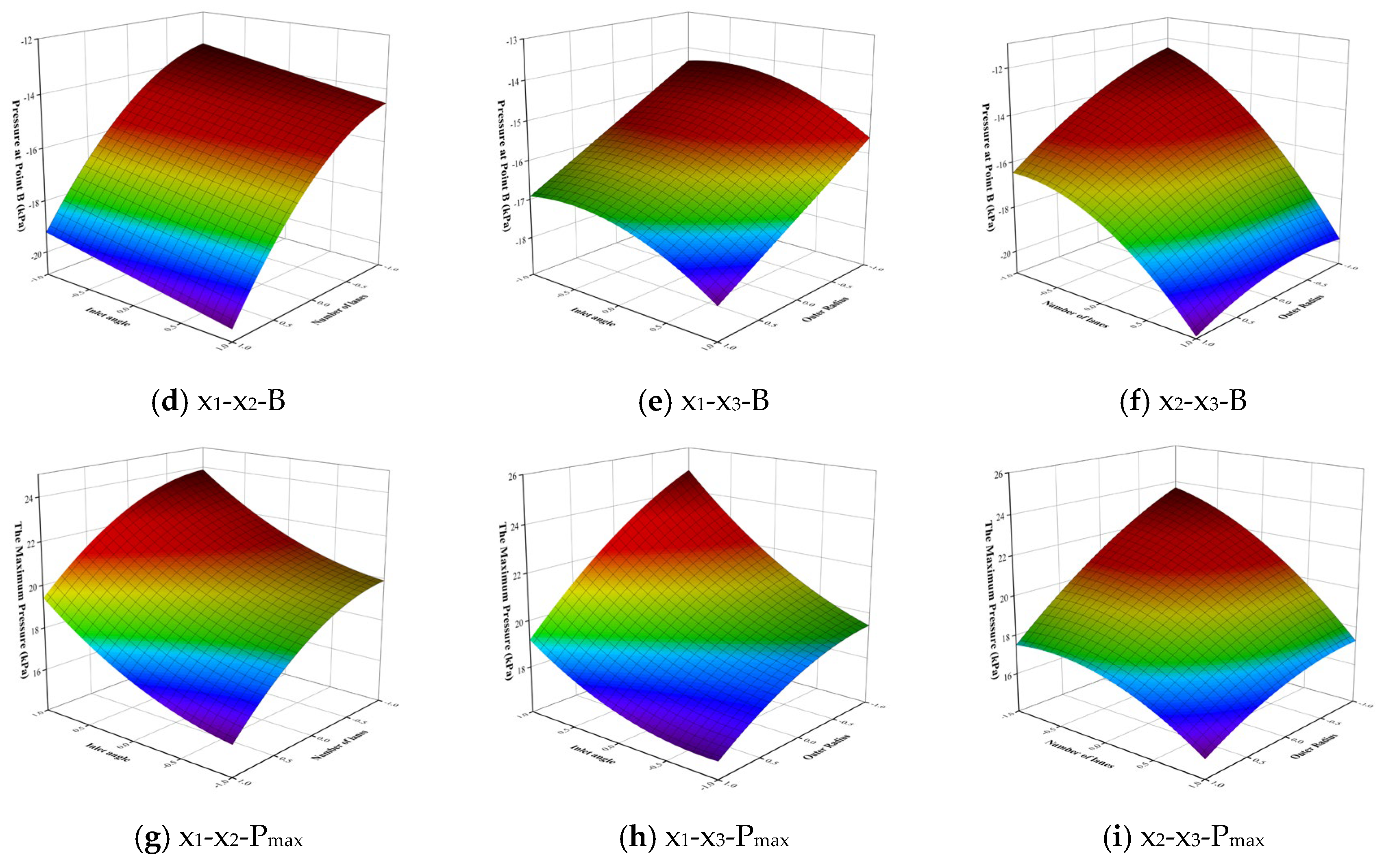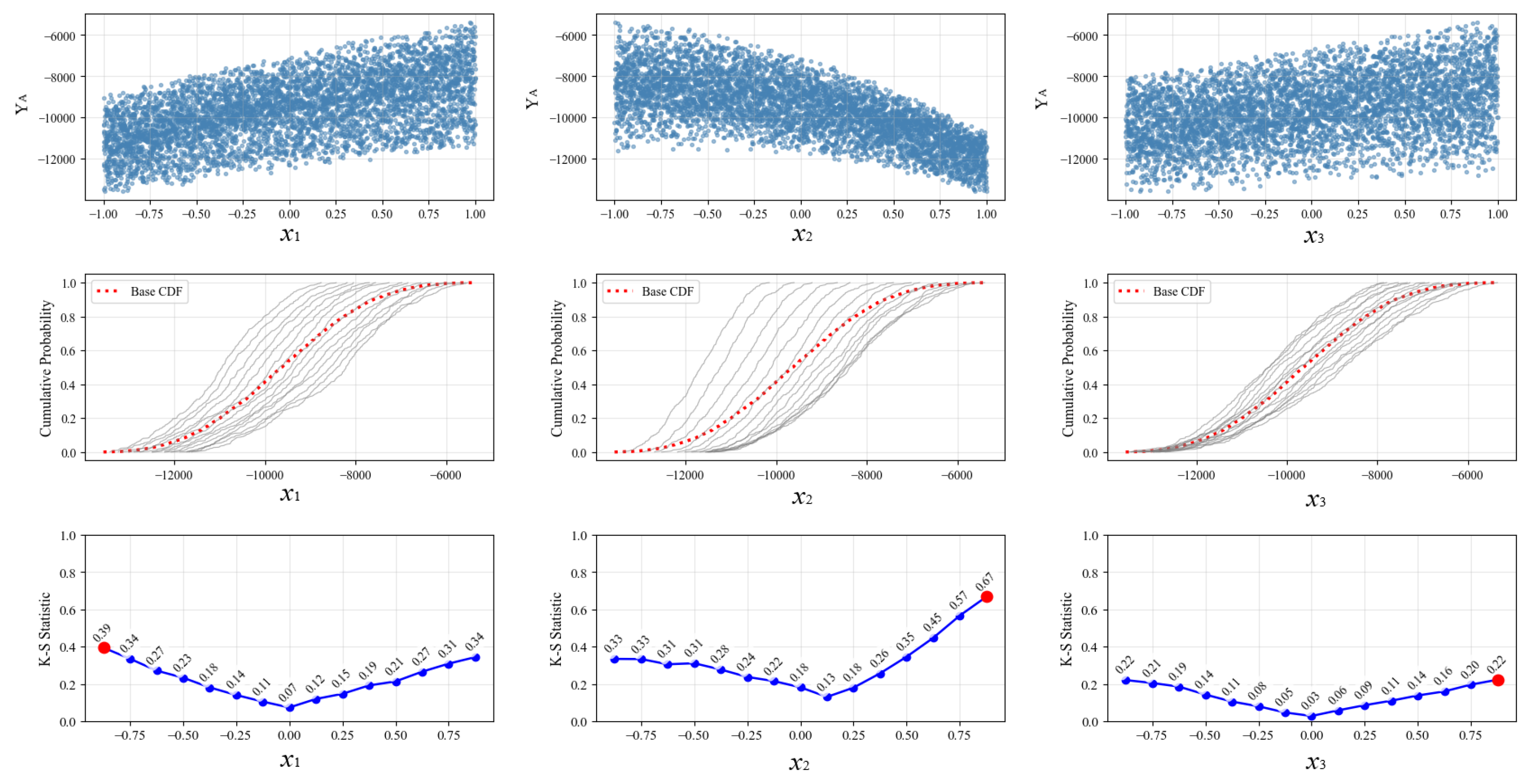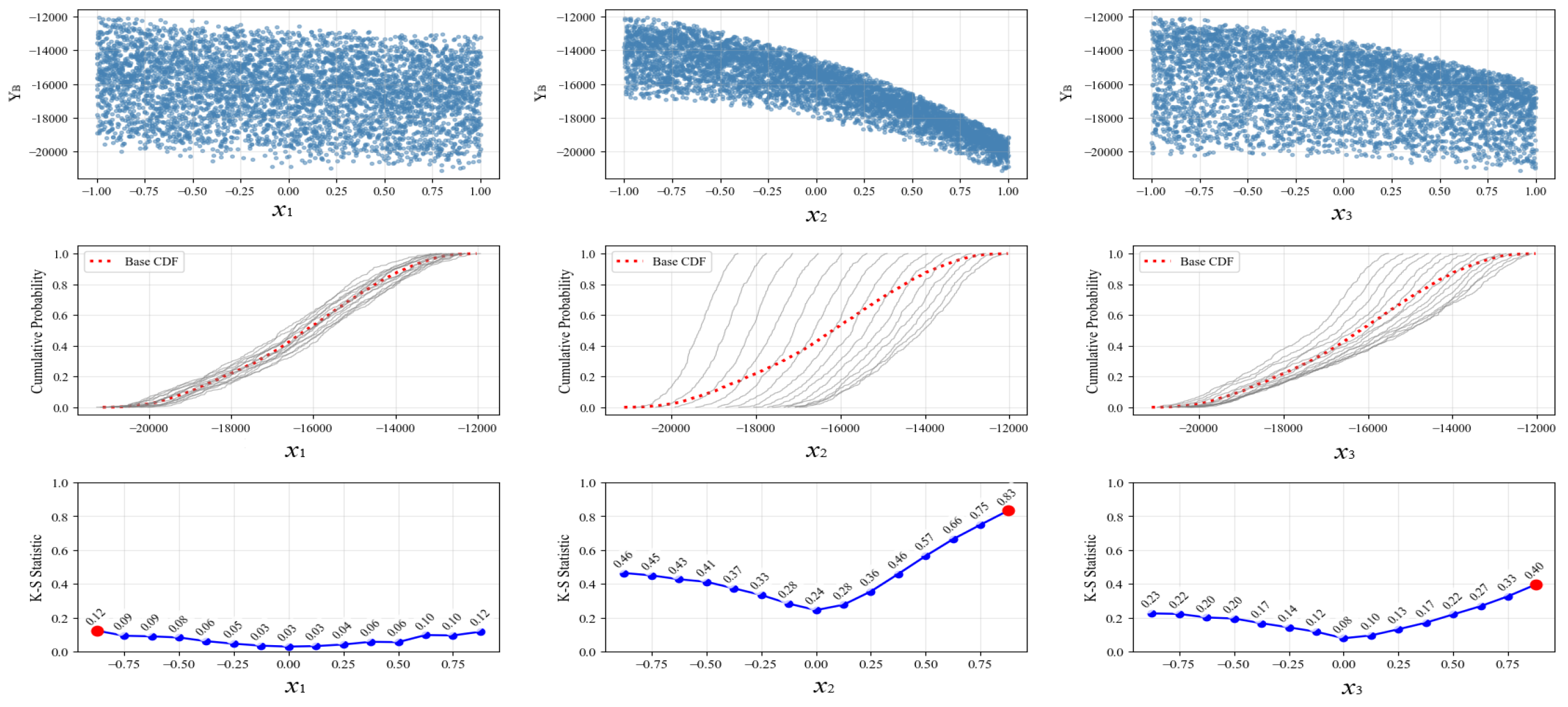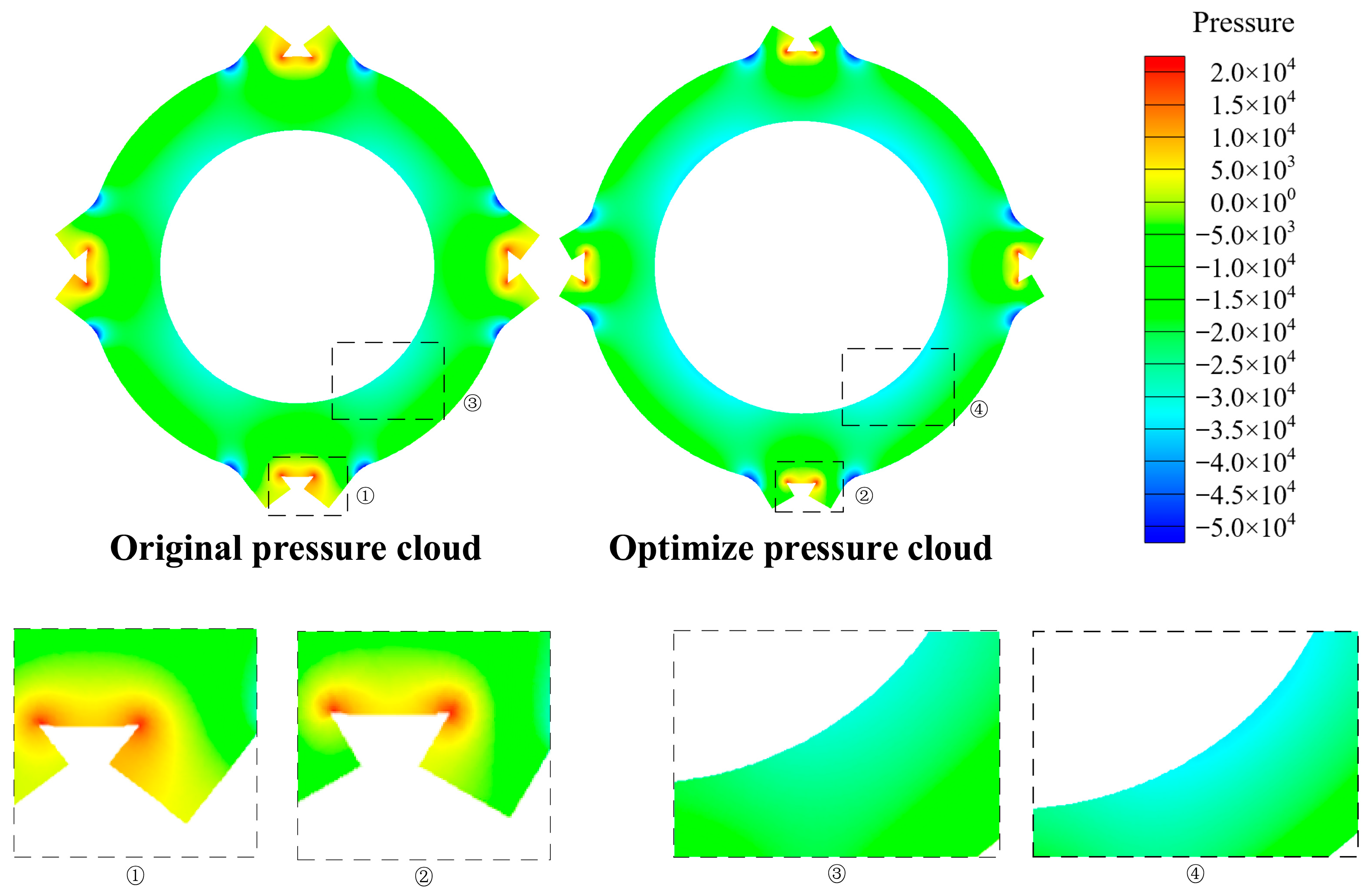3.1. Response Surface Model Construction
The Response Surface Method (RSM) is a method to establish a one-to-one mathematical relationship between the selected road design parameters and the pressure of each feature point based on the experimental design results. For the n-dimensional input factor
, the response target is
. The function expression between the input factor
x and the response objective
y is
where
is the sub-item of the fitting polynomial with order
of
x,
is the coefficient of each item, which is fitted by the least squares method from the response target
, and
is the number of items of the fitting polynomial.
Based on FFD, 112 sample point matrices were generated to construct a response surface approximation model. Then, the significant
p-value analysis of each sub-item of the constructed response surface approximation model is carried out.
Table 4 gives the significant
p-values of each sub-item of the A point, B point, and P
max response surface model under different parameters. In the response surface polynomial,
represents the inlet angle;
represents the number of lanes;
represents the outer radius of the intersection.
For the A point response surface model, the significance p-values of the polynomial sub-items , , , , , , and are less than 0.05, indicating that the above sub-items have significant effects. For the B-point response surface model, the polynomial sub-terms , , , , , and have a significant effect. For the Pmax response surface model, the polynomial sub-formulas , , , , , , , and have a significant effect.
According to the significance
p-value analysis results of each sub-item of the polynomial response surface of point A, point B, and P
max, combined with the significance
p-value analysis evaluation criteria, the sub-items with significant influence are retained, and the sub-items with insignificant influence are removed. Finally, the polynomial response surface approximation model is obtained, and the mathematical relationship is as follows.
The polynomial response surface model is gradually approaching the actual value through the approximate value, so there is a random error in the process of fitting the polynomial response surface model. In order to ensure the accuracy of the fitted response surface approximation model, it is necessary to analyze the error of the fitted response surface approximation model. The commonly used error evaluation criteria are Maximum Error (ME), Root Mean Square Error (RMSE), Average Error (AE), and Coefficient of Determination (R
2). As shown in
Table 4, the 1–3 order error values of the polynomial response surface approximation model of point A, point B, and P
max are given.
From
Table 5, it can be found that with the gradual increase in the fitting order of the polynomial response surface approximation model of A point, B point, and P
max, the values of the polynomial function ME, AE, and RMSE show a decreasing trend. On the contrary, the value of R
2 gradually increases with the increase in the polynomial function fitting order, and the value gradually approaches 1. For the second-order and third-order polynomial response surface, the error of each polynomial response surface approximation model is relatively close, which indicates that the accuracy of the second-order polynomial response surface approximation model is sufficient to meet the design requirements. Therefore, this paper chooses the second-order polynomial to fit the A point, B point, and P
max polynomial response surface approximation model.
3.2. Single-Parameter Influence Analysis
Using the obtained response surface approximation model and the single-factor analysis method, the independent influence of the inlet angle (
x1), the number of lanes (
x2), and the outer radius (
x3) on the A point, B point, and P
max are analyzed, respectively. The influence of specific parameters is shown in
Figure 2.
Figure 2a–c are the curves of point A, point B, and P
max pressure at different inlet angles. It can be seen that with the increase in the inlet angle, the pressure of point A and P
max is positively correlated, and the pressure of point B is negatively correlated. The reason is that as the entrance angle increases, the weaving angle between the vehicle trajectory entering the loop and the vehicle in the loop becomes larger, and the relative speed and conflict degree between the vehicles will also increase accordingly, resulting in a rapid increase in vehicle density and delay at point A and P
max. However, the increase in the entrance angle reduces the speed when the vehicle enters the inner loop, thereby reducing the interference with the inner loop traffic flow and reducing the pressure on the traffic flow at point B of the inner loop.
Figure 2d–f are the pressure change curves of each feature point when setting different numbers of lanes. It can be seen that the pressure of point A, point B, and P
max shows a strong negative correlation with the increase in the number of lanes, indicating that the more lanes set within a certain range, the better the pressure relief effect in the ring. The reason is that with the increase in the number of lanes at the roundabout, the traffic capacity is correspondingly improved, and the vehicles can be more orderly shunted into the roundabout, which reduces the frequency of interweaving and conflict of vehicles in the ring, thus effectively alleviating the traffic pressure in the ring.
Figure 2g–i are the pressure curves of each feature point when the outer radius is different. It can be seen that with the increase in the outer radius, the pressure at point A is positively correlated, and the pressure at point B and P
max is negatively correlated. The reason is that the increase in the outer ring radius of the roundabout leads to the increase in the length of the interweaving area in the ring, and the distribution of the conflict points tends to be dispersed, which reduces the interaction strength and delay within the traffic flow and reduces the pressure of point B and P
max. However, with the increase in the traffic capacity of the ring road, the traffic volume of the intersection also increases accordingly, which leads to the increase in the vehicle interweaving conflict in the interweaving section, and the length of the interweaving section and the vehicle interweaving gap are difficult to adjust and match, which makes the traffic pressure at point A increase.
3.3. Two-Parameter Impact Analysis
The multi-factor and multi-crossover analysis method was used to explore the influence of different key parameters of the roundabout on the pressure of point A, point B, and P
max under the interaction of two. The results of the influence of the three key road parameters of the roundabout on the pressure of each feature point are shown in
Figure 3.
The following two conclusions can be obtained from
Figure 3. First, it can be determined whether the interaction between the three key parameters is significant. For example, the interaction between the inlet angle and the number of lanes in
Figure 3a has a significant effect on point A.
Figure 3b: The interaction between the inlet angle and the outer ring radius is relatively not significant. Secondly, the distribution law of the parameters when the pressure of each feature point is the smallest can be obtained from the results of the interaction of the three key parameters in the above figure. For example, when the number of lanes at the roundabout in
Figure 3c is five lanes, the pressure at point A is the smallest when the radius of the outer ring is 42.5 m.
In addition, in the actual optimization of the roundabout, some key parameters (such as the number of roundabout lanes) may not be adjusted due to physical space constraints, existing structural constraints, high transformation costs, or regulations and policies. When faced with such fixed parameter constraints, the two-parameter influence analysis can provide an alternative optimization approach for road designers.
3.4. Full Parameter Impact Analysis
In the global sensitivity analysis [
42] (GSA) method, the moment-independent sensitivity analysis method is selected to quantitatively analyze the influence of different parameters of the roundabout road design. According to the above, FFD is used to construct the response surface model of A point, B point, and P
max, respectively, and the statistics of the response surface approximation model
of each feature point can be obtained. The moment-independent sensitivity analysis method is applied to the sensitivity analysis of the key parameters of different roads at roundabouts through Python (3.13).
where
and
are the empirical unconditional cumulative distribution function and the conditional cumulative distribution function, respectively.
Then the sensitivity index
of the point A, point B, and P
max response surface model can be calculated:
The main geometric parameters affecting the internal pressure of the ring at the roundabout include the vehicle entrance angle
, the number of lanes
, and the outer ring radius
, which are defined as the following unified form:
3.4.1. Sensitivity Analysis Results of Different Parameters at Point A
Based on the existing response surface approximation model of point A, the sensitivity analysis of different key parameters of the road is carried out by using the moment-independent sensitivity analysis method so as to obtain the quantitative influence degree of different parameters on the pressure of point A. The results of K-S statistical distribution and the cumulative distribution function (CDF) of different parameters are shown in
Figure 4.
Through Formula (13), the sensitivity index
of the different parameters of roundabout road design can be obtained. However, since the expected value is very sensitive to the extreme value of K-S, for some specific conditional values
, the median is used as the summary statistic, supplemented by the maximum value [
43]. The sensitivity index
is shown in
Table 5.
Based on the sensitivity indicators given in
Figure 4 and
Table 6, the following rules can be summarized:
(1) According to the relevant content of CDF, if the distance between the conditional CDF
(gray solid line) and the unconditional CDF
(red dotted line) is larger, or the conditional CDF
is more dispersed around the unconditional cumulative distribution function
, then this parameter has a greater impact on the output response. From the distribution results of CDF with different parameters in
Figure 4, it can be found that the design parameters
and
of the roundabout road have a great influence on the pressure in the ring, and
has the least influence on the pressure in the ring.
(2) According to the relevant content of the statistical sensitivity index, it can be concluded that the larger the value of the sensitivity index is, the greater the influence of the parameter on the response value
is. According to the sensitivity index given in
Table 6, it can be seen that the design parameters
and
of the roundabout road have a great influence on the pressure in the ring, and
has the least influence.
(3) In general, the order of the influence of different parameters on the pressure in the ring is: > > , that is, number of lanes > inlet angle > outer radius.
3.4.2. The Sensitivity Analysis Results of Different Parameters of B Point
Combining the second-order polynomial response surface approximation model of B point fitted by experimental design with the sensitivity analysis method, the sensitivity analysis of different key parameters is carried out so as to obtain the quantitative influence degree of different road geometric parameters on B point pressure. The statistical distribution of different parameters and the results of the CDF are shown in
Figure 5.
According to Formula (13), the sensitivity indexes of different parameters for point B pressure can be obtained. The specific values are shown in
Table 7.
Based on the sensitivity index
for the different parameters of point B pressure given in
Figure 5 and
Table 7, the following rules can be summarized:
(1) From the distribution results of different parameters of CDF in
Figure 5, it can be found that for parameter
, a significant deviation is observed between the conditional CDF
and the unconditional CDF
, indicating that
has the most pronounced influence on the output response. Parameter
also exhibits a moderate impact on the in-ring pressure.
(2) According to the K-S statistical sensitivity index
of the different parameters given in
Table 7, it can be seen that the value of the
sensitivity index is the largest, which indicates that the road design parameter
has the greatest influence on the response output value.
(3) It is found that the influence of different road design parameters on the pressure of point B in the ring is sorted from large to small as follows: > > , that is, the number of lanes > outer radius > inlet angle.
3.4.3. Sensitivity Analysis Results of Different Parameters of Pmax
The sensitivity analysis of different parameters is also carried out. The sensitivity analysis of different key parameters is carried out by the moment-independent sensitivity analysis method combined with the P
max response surface approximation model. The statistical distribution and CDF results of different parameters are shown in
Figure 6.
The sensitivity indexes of different parameters are shown in
Table 8.
From the sensitivity index
of the different parameters listed in
Figure 6 and
Table 8, the following rules can be obtained:
(1) From the distribution results of the different parameters of the CDF in
Figure 6, it can be seen that the difference between the conditional CDF
and the unconditional CDF
of parameter
is the largest, indicating that
has the most significant influence on the output response.
exhibits a secondary influence, while
has a minimal impact.
(2) From the K-S statistical sensitivity index
of the different parameters given in
Table 8, parameter
shows the largest maximum and median values of the sensitivity index
, further confirming its dominant effect on the target response.
(3) Based on the above conclusions, the quantified influence of parameters on the in-ring Pmax follows the order > > , corresponding to outer radius > number of lanes > inlet angle.
